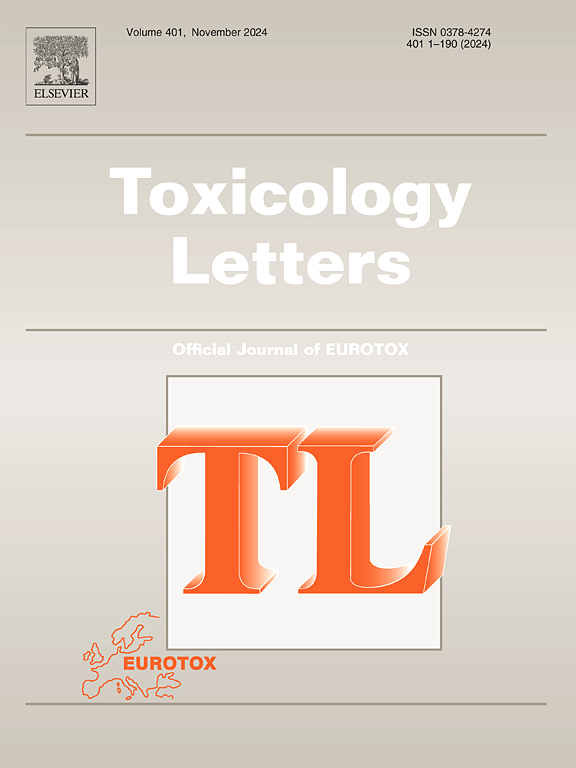Mitigation of gentamycin induced acute kidney injury due to benzothiazole derivatives N1 and N5: Antioxidant and renoprotective mechanisms in-vivo zebrafish
IF 2.9
3区 医学
Q2 TOXICOLOGY
引用次数: 0
Abstract
Acute kidney injury (AKI) is marked by a rapid decline in renal function, often caused by oxidative stress and nephrotoxic agents. Complications limit current therapeutic strategies, and no specific drugs are available to prevent renal injury or accelerate recovery. In the present research, we investigated the therapeutic efficacy of synthesized 2-aminobenzothiazole derivatives, N1 and N5, in mitigating Gentamicin (Gen) -induced renal damage in vivo zebrafish. The preliminary work of radical scavenging and hemolysis inhibition assay revealed that, both compounds exhibited strong antioxidant and anti-inflammatory activities. Furthermore, acute toxicity assays in zebrafish embryo/larvae revealed no adverse effects at concentrations up to 200 μM were tested, highlighting the safety of these compounds. In the zebrafish AKI model, Gen exposure led to oxidative stress, inflammation, and impaired glomerular filtration with tissue damage. Treatment with N1 and N5 significantly reduced ROS levels, apoptosis, and lipid peroxidation and restored antioxidant enzyme activities. Furthermore, N5 treatment improved renal filtration and reduced proteinuria levels, indicating its ability to mitigate nephrotoxic effects. Gene expression analysis showed that N1 and N5 downregulated pro-inflammatory markers (cox-2, tnfα, mpo) and angiogenic mediators (vegf, vegfr2), demonstrating anti-inflammatory and anti-angiogenic properties. Histological analyses revealed that N1 and N5 attenuated glomerular and tubular damage, reduced necrosis, and promoted tissue repair. These findings highlight the potential of 2-aminothiazole derivatives as effective therapeutic agents for AKI, offering antioxidant, anti-inflammatory, and cytoprotective benefits and warranting further investigation into their long-term efficacy in chronic kidney disease models.
苯并噻唑衍生物N1和N5减轻庆大霉素引起的急性肾损伤:斑马鱼体内的抗氧化和肾保护机制
急性肾损伤(AKI)的特点是肾功能迅速下降,通常由氧化应激和肾毒性药物引起。并发症限制了目前的治疗策略,并且没有特定的药物可以预防肾损伤或加速恢复。在本研究中,我们研究了合成的2-氨基苯并噻唑衍生物N1和N5对庆大霉素(Gen)诱导的斑马鱼体内肾损伤的治疗效果。初步的自由基清除和溶血抑制实验表明,两种化合物均具有较强的抗氧化和抗炎活性。此外,在斑马鱼胚胎/幼虫中进行的急性毒性试验显示,浓度高达200 μM时没有不良反应,强调了这些化合物的安全性。在斑马鱼AKI模型中,Gen暴露导致氧化应激、炎症和肾小球滤过功能受损,并伴有组织损伤。N1和N5处理显著降低ROS水平、细胞凋亡和脂质过氧化,恢复抗氧化酶活性。此外,N5治疗改善了肾滤过和降低了蛋白尿水平,表明其能够减轻肾毒性作用。基因表达分析显示,N1和N5下调促炎标志物(cox-2、tnfα、mpo)和血管生成介质(vegf、vegfr2),表现出抗炎和抗血管生成的特性。组织学分析显示,N1和N5可减轻肾小球和小管损伤,减少坏死,促进组织修复。这些发现突出了2-氨基噻唑衍生物作为AKI有效治疗剂的潜力,具有抗氧化、抗炎和细胞保护的益处,值得进一步研究其在慢性肾脏疾病模型中的长期疗效。
本文章由计算机程序翻译,如有差异,请以英文原文为准。
求助全文
约1分钟内获得全文
求助全文
来源期刊

Toxicology letters
医学-毒理学
CiteScore
7.10
自引率
2.90%
发文量
897
审稿时长
33 days
期刊介绍:
An international journal for the rapid publication of novel reports on a range of aspects of toxicology, especially mechanisms of toxicity.
 求助内容:
求助内容: 应助结果提醒方式:
应助结果提醒方式:


